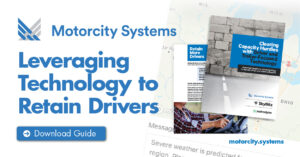Maximize Your Assets, Improve Your Experiences with Technology
Ongoing supply chain challenges that are contributing to backlogs and delays are forcing motor carriers and fleet managers alike to re-evaluate the assets they have already have at their disposal. It’s all about answering two key questions: How can I get the most out of what I currently own? In turn, how can I improve my drivers’ experiences so they stick with me?
Those who pivot and rethink what’s possible with technology and try new things to improve conditions for their workforce are outpacing their competition, attracting and retaining top talent, and setting themselves up for long-term success.
Embracing new tools and technology
In the transportation sector, trailers have traditionally been a secondary concern to trucks since fleets could rent, lease or purchase equipment to meet immediate or seasonal needs. But now, motor carriers are reassessing their existing trailer assets to understand where efficiencies can be introduced due to the backlog in trailer manufacturing.
According to ACT Research’s quarterly report on trailer components, the U.S. trailer industry backlog grew 3% sequentially at the end of 2021 (but ended 9% below the previous year).
Modern technology solutions can help motor carriers and fleet managers more fully utilize the assets they have on hand. With trailer tracking systems and smart sensors, for example, they can:
- Maximize utilization by digitizing “yard checks” and reporting idle times and other key metrics for each location where they have trailer pools. This provides a deeper understanding of the assets and utilization trends at each location to ultimately increase driver productivity and move assets to where they are needed most.
- Improve visibility: Use advanced cargo sensors to gain visibility into when assets are loaded and ready for pickup or empty and available for use. Smart camera technology can scan the full length of the floor and report trailer fullness in terms of the percentage of cube and floor space utilized, so that fleet managers know with certainty the status of trailers (i.e. what’s loaded, unloaded and what percentage of capacity is available to optimally match equipment with loads).
Other cloud-based systems that connect to existing devices can improve both mobile and office environments by allowing managers to easily communicate with drivers in specific groups such as geographies or driver classifications, and can provide instant visibility of driver status, including available hours of service and dispatch assignments. What’s more, if on-prem systems are down, managers and drivers can maintain communication with robust, cloud-hosted applications.
These solutions not only improve efficiency and effectiveness within day-to-day operations, but they can have a true, positive impact on the workforce as well.
Prioritizing the workforce
It’s as simple and straightforward as this: we need to better prioritize our people. Have you taken the time to listen to and understand the frustrations that your drivers are experiencing? Do you know what ideas and solutions they have in mind to make their experience more positive? The challenge is clear – with the average trucking company experiencing a turnover rate of roughly 95 percent within one year.
There are modern tools and technologies that can help solve most, if not all, drivers’ key frustrations – making them feel safer, more informed, more efficient, and ultimately, happier. If motor carriers and fleet managers start to prioritize their people in a more intentional way, the problems they’re currently facing in terms of recruitment and retention will likely fall by the wayside.
Again, modern trailer tracking and driver communications systems can eliminate delays that drivers currently experience with many legacy systems and therefore reduce frustrations with operations by:
- Incorporating certainty into dispatch: Provide drivers with the exact location of trailer assignments and verify the status of cargo and equipment to utilize driver time effectively.
- Adding smart sensors: Proactively monitor the health of trailer components to help prevent scenarios where drivers are assigned to trailers that are not roadworth.
- Leveraging instant messaging: Add dispatcher-driver messaging capabilities to increase driver efficiency and improve driver job satisfaction by eliminating communication delays.
Driver safety also needs to be better prioritized. With advanced AI-backed camera systems, for example, drivers can receive proactive alerts if they’re exhibiting risky or unsafe driving behaviors. This allows them to address the issue such as speeding or following distance, which ultimately keeps both the driver and others safer while on the road.
There’s no time like the present to take note of what the workforce is telling you and incorporate new systems and simple changes to improve their experience. What’s more, by improving the driver experience, motor carriers and fleet managers can improve overall asset management.
Download Leveraging Technology to Retain Drivers more about the solutions that can help improve driver retention and asset utilization.

